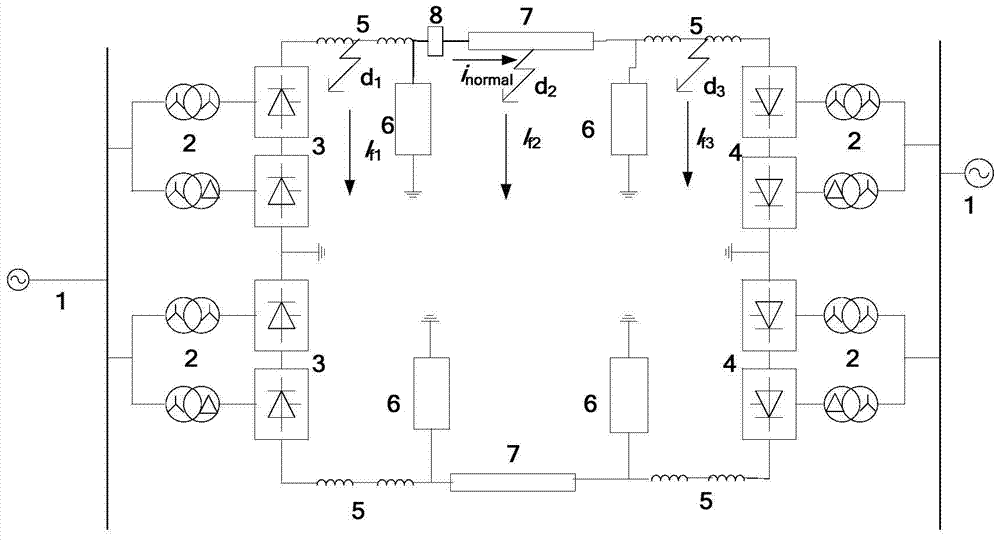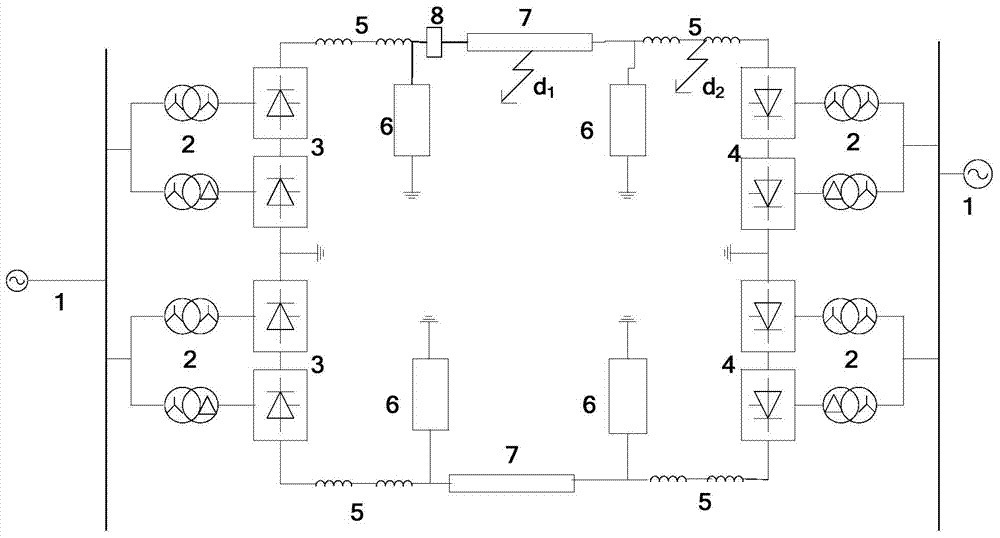A single-end protection method for UHV DC transmission lines
A technology for UHV DC and transmission lines, applied to emergency protection circuit devices, electrical components, etc., can solve the problems of slow protection action, easy refusal, and low sensitivity of current differential protection, so as to ensure quick action and good speed Dynamic, to achieve the effect of full-line protection
- Summary
- Abstract
- Description
- Claims
- Application Information
AI Technical Summary
Problems solved by technology
Method used
Image
Examples
Embodiment 1
[0035] Embodiment 1: as Figure 1-2 As shown in the figure, a single-ended protection method for UHV DC transmission lines, firstly use the data acquisition device to collect the fault current data in the time window 5 ms after the arrival of the first wave of the fault current traveling wave and calculate the 1-mode component; then the 1-mode component Subtract the 1-mode current in normal operation before the fault from the current signal to obtain the fault current variation and sum it, and then judge whether the signal comes from outside the rectifier side area or from the line or inverter side area according to the summation result; For the fault current signal from the line or outside the inverter side area, use the Hilbert-Huang transformation to obtain the maximum value of the instantaneous frequency, and then compare the maximum value of the instantaneous frequency with the preset threshold value to judge the fault Occurs on the line or outside the inverter side area....
Embodiment 2
[0045] Embodiment 2: as Figure 1-2 As shown in the figure, a single-ended protection method for UHV DC transmission lines, firstly use the data acquisition device to collect the fault current data in the time window 5 ms after the arrival of the first wave of the fault current traveling wave and calculate the 1-mode component; then the 1-mode component Subtract the 1-mode current in normal operation before the fault from the current signal to obtain the fault current variation and sum it, and then judge whether the signal comes from outside the rectifier side area or from the line or inverter side area according to the summation result; For the fault current signal from the line or outside the inverter side area, use the Hilbert-Huang transformation to obtain the maximum value of the instantaneous frequency, and then compare the maximum value of the instantaneous frequency with the preset threshold value to judge the fault Occurs on the line or outside the inverter side area....
Embodiment 3
[0054] Embodiment 3: as Figure 1-2 As shown, a single-end protection method for UHV DC transmission lines, the specific steps of the method are as follows: a ground fault occurs on the positive busbar at the rectification side, and the transition resistance is 1 ohm. Collect the current on the two-pole lines in the window 5ms after the arrival of the first wave head of the fault traveling wave, and obtain the 1-mode component of the current; obtain the fault current variation Δi (where, in this example, i normal It is the value when the system is in full load and normal operation, the value is 6.25kA), and then use the formula to get the P value -148.8482, which is judged to be an out-of-area fault on the rectifier side, and the protection does not operate.
[0055] Because the sampling rate in the present invention is 10kHz, and the sampling time window is 5ms, the K value used is 50, which is the same in the following examples.
PUM
 Login to View More
Login to View More Abstract
Description
Claims
Application Information
 Login to View More
Login to View More - R&D
- Intellectual Property
- Life Sciences
- Materials
- Tech Scout
- Unparalleled Data Quality
- Higher Quality Content
- 60% Fewer Hallucinations
Browse by: Latest US Patents, China's latest patents, Technical Efficacy Thesaurus, Application Domain, Technology Topic, Popular Technical Reports.
© 2025 PatSnap. All rights reserved.Legal|Privacy policy|Modern Slavery Act Transparency Statement|Sitemap|About US| Contact US: help@patsnap.com



